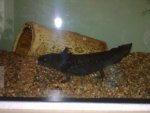G'day all,
I have had my axolotl for about a week now and I am starting to suspect that she is either consipated or impacted. Her stomach looks rather full, her tail is elevated, she is tilting a little and seems a bit wonky on her feet. I have noticed that she has been eating some of the gravel (although she spits the majority of it out). I have very fine gravel in the tank, that I was told should pass through relatively easily by the lady at the aquarium. Other than that, she is eating well ( i feed her a mixed diet of pellets, earthworms and fish) and seems relatively happy (no fungus, white patches and her gills aren't forward) and active.
My question is more about treatment. From what I have read on this forum and others, the best option is to put her in the fridge, but should I do this right away, or do I wait a while. I have only noticed the tilting and swollen stomach over the past couple of days and considering that she is eating fine, I am reluctent to do anything too drastic. Any thoughts? Do I stop feeding her? Is there any specific food to give to try and rectify this problem?
Also, I think she has pooed maybe once since I have had her ( I say maybe because I wasn't sure it is was faeces or whether she spat up some of the pellets, as it looked like undigested pellets). How often should she be pooing?
Thanks
Paul
I have had my axolotl for about a week now and I am starting to suspect that she is either consipated or impacted. Her stomach looks rather full, her tail is elevated, she is tilting a little and seems a bit wonky on her feet. I have noticed that she has been eating some of the gravel (although she spits the majority of it out). I have very fine gravel in the tank, that I was told should pass through relatively easily by the lady at the aquarium. Other than that, she is eating well ( i feed her a mixed diet of pellets, earthworms and fish) and seems relatively happy (no fungus, white patches and her gills aren't forward) and active.
My question is more about treatment. From what I have read on this forum and others, the best option is to put her in the fridge, but should I do this right away, or do I wait a while. I have only noticed the tilting and swollen stomach over the past couple of days and considering that she is eating fine, I am reluctent to do anything too drastic. Any thoughts? Do I stop feeding her? Is there any specific food to give to try and rectify this problem?
Also, I think she has pooed maybe once since I have had her ( I say maybe because I wasn't sure it is was faeces or whether she spat up some of the pellets, as it looked like undigested pellets). How often should she be pooing?
Thanks
Paul





